The Philosophers' Stone
How to Transmute the Elements by Engineering the Geometry of Standing Waves
by T.B. Pawlicki
A series of experiments has been carried out in Japan proving that chickens fed a diet deficient in calcium produced, as the end product of their biological processes, more calcium than they were given to live on. The conclusion is that the chickens created the calcium they needed by transmuting potassium.
This discovery challenges the basic concepts of science, and the more critically a discovery challenges the foundations of scientific belief, the less it is examined at all. But if potassium can be transmuted into calcium (and by chickens, no less), we had best construct a new model of the atom to explain how this might be possible. So let's get started, at the level of the subatomic particles that seem to be giving theorists so much difficulty.
After observing that light travels in straight lines to cast sharp shadows, Isaac Newton deduced that light beams could exist only if radiant energy possessed the characteristics of atomic particles. But Sir Isaac went on to pass beams of light through prisms observing the spectrum of colors projected. The fractioning of light into colors is possible only if radiant energy possesses the properties of waves.
The problem became a matter of determining whether light was particulate or wavy in nature. Theorists decided that the ultimate elemental substance was both particle and wave, depending upon what it happened to be doing with itself when observed. Then realists proceeded to advance science without caring what light was. Nevertheless, the problem for the philosophers remains. The properties of particles categorically exclude the properties of waves, so how is it possible for an elemental substance, whatever it is, to manifest both properties in successions?
After the greatest scientists since Newton have given up, all a lay person has to do is take a couple of cartons of quarter-inch ball bearings to a billiard parlor, rent a table, and spread balls on the baize.
After you have managed to arrange them with a mathematically random distribution, you will see that each ball is equally distant from its neighbours Absolute chaos is identical to perfect order.
Now try to rearrange the balls so that groups are allowed, but the groupings are mathematically random. Eventually the pattern formed by the balls will follow a density of distribution described by the Bell Frequency Curve of random statistics. The Bell Frequency Curve is a sine-wave form; on a plane surface it is manifest as regular clusters, with small groups of roughly equal numbers being roughly equal distances apart. The smaller groups congregate into larger groups until the entire field can be described as a single sine-wave form of low frequency. Once again, you prove that utter disorder is identical to total organization.
If the balls are small enough and numerous enough in relation to the area you have to spread them on, you will discover the aggregations of particles will assume the pattern of a spiral generated by phi, the ratio between successive numbers in a series extended by adding consecutive numbers together; it is the ratio of 1:1.1618. All natural growth eventually fallows the form of a spiral generated by a phi ratio, from the distributions of atoms to the distributions of stars in galaxies. (In other words, the spiral structure of gas clouds in interstellar space is not necessarily due to the process of gravitational contraction and centrifugal force, as proponents of the Nebular Hypothesis of stellar generation would have us believe. The spiral structure is an inevitable consequence of random distribution.)
You can perform this experiment at less cost by making pencil dots on a large piece of paper, but you will be bothered by constant erasing until you get the dots distributed properly. With pencil and paper, however, you can perform the converse experiment. Draw lines at random, each line representing a wave front. If you have enough lines on enough paper, and enough randomness, the result will look exactly like the random distribution of balls on a billiard table, as the intersections of lines form groupings of density.
Whether you perceive a ball to be an atomic particle or an aggregation of particles depends upon the scale of your frame of view. Whether you perceive an aggregation to be a particle or a wave depends upon the scale of your resolution. At the limit of resolution, all structures register on all instruments of measurement as particles. And all structures that cannot be resolved sharply by the instrument of measurement register as waves. So the nature of the ultimate element is determined by the instruments of measurement; all we can really know about it is what our instruments measure. Whether you choose to interpret reality as waves or particles depends entirely on what you want to do. The manifestations of energy - i.e., motion - yield measurements as waves; the manifestations of static material yield measurements as particles.
As it happens, everything is moving. Therefore, all events yield accurate measurements only as wave functions. The use of the laser for measurement establishes the wave as the elemental unit of space, time, motion, and energy.
As when Pythagoras studied music, harmonics is still taught from the model of a vibrating string. A plucked string vibrates back and forth as a unit, forming a standing-wave structure, emitting vibrations through the air to be heard as a musical sound. The tone is the fundamental frequency of the standing wave.
As the string vibrates as a unit, it also divides itself into two halves along its length, and each half vibrates as two individual standing waves independently of the fundamental wave. The frequency of the half lengths is twice the frequency of the fundamental, and the sound emitted is the second harmonic overtone, an octave higher than the fundamental.
And at the same time as the string vibrates as a unit and as independent halves, it also divides its length into three equal parts, each third vibrating independently to emit a sound three times the frequency of the fundamental, called the third harmonic overtone. At the same time, the string also divides itself into fractional lengths of quarters, fifths, sixths, and so on to the elemental molecular unit of vibration, generating successively higher harmonic overtones all the way. The distribution of energy among the overtones determines the unique sound characteristic of each instrument. This is the way harmonics is taught.
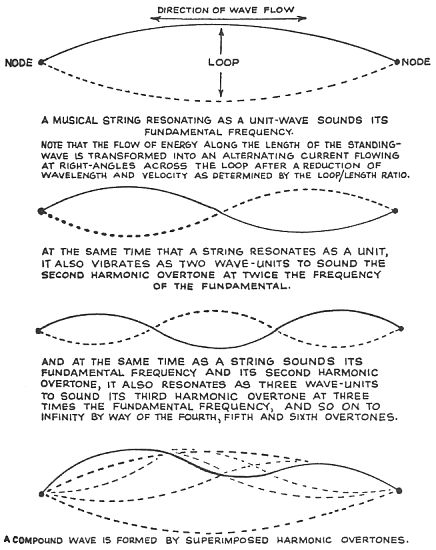
Only one thing is wrong with the course of study: The instructors got it all backward, just as electricians are taught that electricity flows in the opposite direction from the way it really flows. Now all the musicians and acoustic engineers will protest; everyone can see the vibrating string, and the course in harmonics describes exactly what you see doesn't it? No, what is really happening is random motion. Whether or not you can hear the vibrations of a musical string above the audible threshold, the string is always vibrating due to the random molecular agitation of heat. (As far as the string is concerned, the extra vibration it gets from being plucked is just more heat.) Molecular motion along the string arranges itself into increasingly longer sine waves according to the Bell Frequency Curve of random distribution, until all the various fractional vibrations come into phase to generate the fundamental frequency. Fractions which do not coincide with the lower harmonics travel back and forth along the length of the string as moving waves until they come into direct opposition, transforming them into electromagnetic radiation. It's the loss of energy through electromagnetic transformation that causes the molecular vibrations to die down.
Electricians continue to learn their subject backward because which way the current flows makes no difference to the wiring; and besides, alternating current flows both ways. So what difference does it make whether harmonics is taught as division or integrations. Well, as long as you believe electricity flows from positive to negative, you will never be able to discover and implement electronics.
If you learn harmonics by distributing ball bearings on a pool table, the way Pythagoras did after he was initiated into the higher dimensions and forswore beans, you will discover how the universe unfolds.
An infinite number of particles distributed and moving randomly through infinite space will divide themselves along a fundamental axis; one half moving in one direction and the other half moving in the opposite direction. This flow corresponds to gravity and antigravity. The reason we rarely see antigravity is that all particles belonging to the opposite pole have already departed in the other direction, and very few are left around here.
Each half of the universal particles traveling in opposite directions along the fundamental axis will divide into two groups again, moving in opposite directions along a plane at right angles to the gravitational axis. This secondary harmonic corresponds to the centrifugal and centripetal forces. The second harmonic will also subdivide into another pair of equal and opposite accelerations that can be represented as a cylinder parallel to the centrifugal-centripetal plane. The tertiary harmonic corresponds to the precessional forces.
Like the conventional view of the musical string, the universe can be described as subdividing itself successively until the ultimate particle is reached whatever that ultimate particle is.
Of course, the universe does not really divide itself in this manner any more than the musical string does. It assembles its harmonics from random motion to coherent undertones. We proceed to analyze from the fundamental to the overtones only because it is convenient for our habit of thinking. We shall never know where the universal fundamental axis is, nor what the ultimate particle is, because in an infinite universe we must always find ourselves exactly in the middle of an infinite extension in both directions of whatever dimension we happen to be considering. What we call gravity, centrifugal-centripetal, and precessional forces are merely arbitrary conventions established for the convenience of our habitual mode of perception.
Once we perceive that all parts of space contain an indefinite number of particles moving at random to form the force fields we are familiar with, we understand how to engineer field energies directly. You see, one phase of precessional acceleration proceeds in the same direction as antigravity. To invent an antigravity engine, therefore, all you have to do is amplify the centrifugal harmonic until the antigravitational phase of the precessional harmonic exceeds the acceleration of gravity, and then eliminate the gravitational phase. This is exactly what Professor Eric Laithwaite calculated; he failed only because of errors in arithmetic. Other engineers have found the errors and corrected them. Whether or not the Laithwaite Engine worked, the fact remains that all antigravity engineering and all other field engineering can be reduced to the geometry of harmonics generated by random particles.
An infinite universe defined by an infinite number of randomly moving particles establishes the scientific principle of parity, meaning that energy will be equal in all directions and at all locations. In current physics, the concept of the cosmic hologram is still not accepted, so panty is limited to equality of motion in all directions.
When all the vectors of the gravitational-fundamental vibration and the centrifugal-centripetal secondary harmonic and the precessional tertiary harmonic and all the other harmonics are integrated into a resultant, the trajectory of any given particle must follow the course of a spiral vortex with a phi generator. Therefore, any part of space you choose as a frame of reference will be defined by a fundamental field vortex, subdivided into an indefinite number of harmonic overtone vortices.
A vortex can spin in only one direction. Parity demands that for every vortex there must be a countervortex. This is why all dynamic structures are created, like men and women, in equal and opposite numbers.
Two vortices spinning in the same direction flow in opposite directions along their interface, Therefore, if pushed together. they will annihilate each other. This is why when particle meets antiparticle, they are transformed into radiant energy. The closer two vortices spinning in the same direction are pushed together, the more energy is brought into opposition along their interface. Therefore, all vortices rotating in the same direction will tend to move away from each other until they are spaced equally apart.
Conversely, two vortices spinning in opposite directions are flowing in the same direction along their interface. Therefore, they tend to merge. But they are not drawn together so much as pushed together by the pressure of similar vortices.
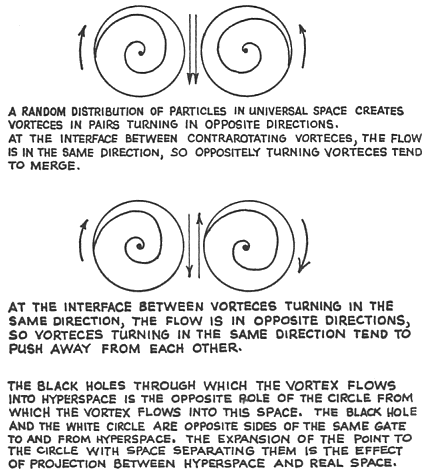
It is evident that the mechanics of vortices determines the force physicists call charge. Spin determines polarity.
Physical experiment has proven conclusively that electrons and protons are monopoles. The fact that electric charge is monopolar while magnetic charge is dipolar is one of the problems in the search for a Unified-Field Theory. If the vortex model is valid, however, electrons and protons should be dipolar, depending on which way they are oriented. But protons always repel each other, so all respectable physicists are convinced the vortex model is mistaken.
But protons do not always repel each other! When they come close enough together, they cleave together with greater force than any glue known. Physicists call this attraction the nuclear force, and they are unable to explain why it can be so powerful, but only over extremely close distances, within the nucleus of the atom. The answer is self-evident by a simple experiment. If you float a number of bar magnets in a fluid medium, and enclose the experimental setup in an electromagnetic field, the field will align all the magnets in the same direction and they will repel each other like protons. But if the magnets are small enough, and are brought closely enough together, the mutual attraction of their opposite poles will overcome the force of the external field keeping them aligned - and they will flip, one relative to the other. With opposite poles tightly together, they will cleave together most tenaciously over a short distance. But once separated beyond the critical distance, the external field will align them in the same direction, and they will repel each other again. Scientists have come to perceive the electromagnetic field aligning particles in an atom as the electromagnetic field, so when particles flip and join in the nucleus with a thousand times more force than the attraction between proton and electron, a radically new force is postulated.
As it happens, Immanuel Velikovsky proposed an equivalent hypothesis to explain why planets in the Solar System do not collide. You see, if there is mutual gravitational attraction among the planets, they must clump together over the course of time. But observations prove that the planets maintain the greatest possible distance from each other. When an extreme condition is maintained indefinitely, you cannot explain it as accidental; there must be a physical force keeping the planets apart. Unfortunately, it was Velikovsky who proposed this hypothesis, and no scientist who is not independently wealthy and careless of reputation can afford to prove anything that Velikovsky said.
Field forces are defined, by many criteria, so physicists may be on firm ground when they establish a nuclear force distinct from the electromagnetic force - but the experiments proving electrical particles to be monopolar do not contribute to that support.
When harmonic calculations are transferred to spaces of more than one dimension (the musical string is the standard object lesson), the same principles are assumed to be valid. As a consequence, spherical harmonics is interpreted as a circular wave expanding from a point of origin on the global surface, and the harmonic ratios are measured along a radius. This conception works very well as far as it goes, but as you will learn, plane harmonics has some extremely practical differences from linear harmonics.
A plane cannot exist as a vibrating structure unless it has at least three sides. The triangle, therefore, must be established as the fundamental unit of plane harmonics. When the sides of an equilateral triangle are bisected and joined, the result is four triangles, just as a square makes four squares when its sides are bisected and joined. The operations of plane harmonics apparently observe the rules of plane geometry.
William H. Whamond, writing in Pursuit, pointed out that if the sides of a polygon are not of a ratio that mutually reinforces each other's vibrations, the plane structure will disintegrate. All equal-sided polygons maintain their sides by mutual reinforcement, but all those which cannot be triangulated in harmonic ratios must collapse under pressure. It is surprising that Buckminster Fuller was able to build a career without realizing the function of harmonics in maintaining basic stability of structure.
Whamond went further to point out that although stabilizing the dimensions of diagonals may be sufficient for practical structures, theoretical requirements are not satisfied unless the diametric vibratiom reinforce the perimetric vibrations to establish the polygon's rigidity through and through. The simplest polygon generated by a mutually harmonic reinforcement of both sides and center is the hexagon. This is the probable reason why six acquired a reputation for being the perfect number among the ancient philosophers, and why a circle's circumference was accepted as being three times its diameter. although every wheelwright knew better.
If you draw a grid of squares, and then draw all the diagonals, you will find yourself with a grid composed of two sets of squares. One set is rotated forty-five degrees from the other, and their dimension are related to each other by a ratio of the square root of 2. This self-evident transformation assumes engineering significance when harmonic structures extend into higher dimensions.
As Buckminster Fuller pointed out, not only is the triangle the basic unit of plane space, but the principle of triangulation also establishes the tetrahedron as the basic unit of solid space. Like the triangle, however, the tetrahedron maintains its structure only by the triangulated rigidity of the mutually reinforcing vibrations of its sides. In order to possess internal stability, the tetrahedron must be doubled, one intersecting another, with points aligned on a polar axis.
To establish stability, tetrahedrons must always be manifest in mutually opposed and supporting pairs in this way. When this geometrical structure takes form from universal vibrations, however, it is not the simple pair of tetrahedrons it appears to be at first sight.
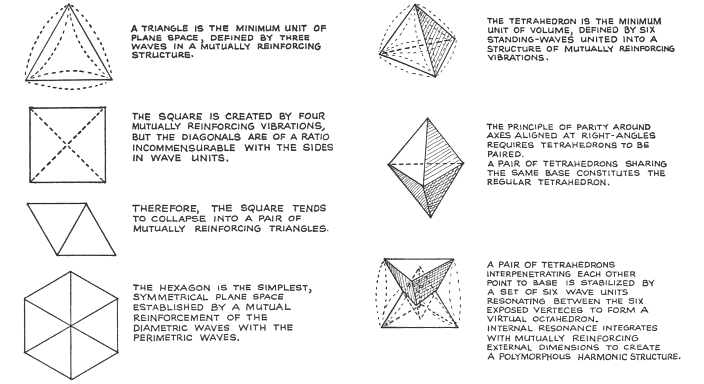
If lines are drawn joining all the points of the paired tetrahedrons, you have a cube. If lines are drawn between the centers of each face of the cube, they form the edges of an octahedron.
If circles scribed around the bases of the two tetrahedrons are divided into five equal arcs and all the points joined by lines, a symmetrical polyhedron defined by twenty equilateral triangles is defined. If all the points are joined by lines through the center of the icosahedron, twenty equal tetrahedrons will be defined. The space defined by an icosahedron is stabilized by mutually reinforcing resonance around all sides, along all edges, and through all diameters. Like the hexagon, the twenty faceted icosahedron is the perfect solid.
Now, bisecting all the lines forming an icosahedron produces a twelve sided symmetrical polyhedron called a dodecahedron - the solid projection of the five-pointed star circumscribed by a pentagon. All ratios of the dodecahedron approximate the values of various mystical triangles, but they are incommensurate with the icosahedron by integers; the internal structure of the dodecahedron is irrational, like pi, phi, root 2, root 3, root 5, etc. As you know, the diagonal of a square is related to its sides by root 2 and the diagonal cross of a square is also the negative of the square. The dodecahedron is the negative of the icosahedron. In this context, the octahedron is the negative of the cube.
Because a tetrahedron is the elemental unit of solid space, no other polyhedron can function as its inferior negative, so the tetrahedron is rotated 180 degrees to function as its own solid negative. Lines drawn from the points of a tetrahedron to its internal center form a linear structure called the Miraldi angle, resembling a caltrop, this is the true negative of the tetrahedron, but the field rotation required to transform a tetrahedron into a caltrop projects the structure into fewer dimensions.
Now, the relationship between a square and its diagonals is a 45-degree rotation on plane space, which is the projection of a rotation of 90 degrees in hyperspace. The relationship between the tetrahedron, the octahedron, the cube, the dodecahedron, and the icosahedron is also established by a definite rotation through hyperspace. The notes of a musical scale are also defined by a definite rotation of energy through hyperspace, which transforms one frequency into another. As an illustration, rotation through hyperspace transforms the wavelength of the side of a square to the wavelength of its diagonal. The ratio of the side to the diagonal is the same as the ratio between G and C on the musical scale.

You have just made a discovery sought by philosophers throughout history; the regular Platonic solids are related to each other as musical notes on a hexatonic scale. Extend the sides of the dodecahedron until they meet, and you have the frame of a pair of tetrahedrons exactly twice the size of the pair you started with to continue the scale on the second octave. You have discovered the Music of the Spheres.

Parity is not satisfied by the creation of nuclear particles in the form of equal and opposing standing-wave vortices. The axes of the pair, you see, are both aligned in the same direction; that is a manifestation of directional preference. In order that axes be balanced in all directions, particles must congregate in groups of six; three pairs of mutually opposed particles with the axis of each pair at right angles to the other two. This assemblage puts each vortex at the vertex of an octahedron.
The octahedron is not stable because each pair of vortices grind gears against the other two. But if the equatorial pair of particles move away from each other along the polar axis, the six can mesh together like two pairs of crown gear clusters fitted at right angles to each other.
The vortex model suggests that the basic particle is likely to be composed of three pairs of finer particles bound together in the harmonic structure of an octahedron. The geometry of the three pairs bears a striking correspondence to the characteristics of the elusive quark. Charm, beauty, and color appear to he manifestations of angle in hyperspace; axial angles account for fractional electric charge.
The octahedron still does not quite satisfy parity. The polar pinions of the crown gear clusters are both spinning in the same direction; this will give the octahedron a net charge. If four more pair of vortices, forming the negative of the octahedron, are spaced in a cube arrangement between the vertices of the octahedron, all the gears will spin in the right direction, all spins will be equally opposed, and all axes will be balanced in all directions. The cube-octa is the likely conformation of the neutron. Proof will be slow coming because at least half the particles are in the quantum field at the instant any measurement is made; this is why the quarks are so damned elusive.
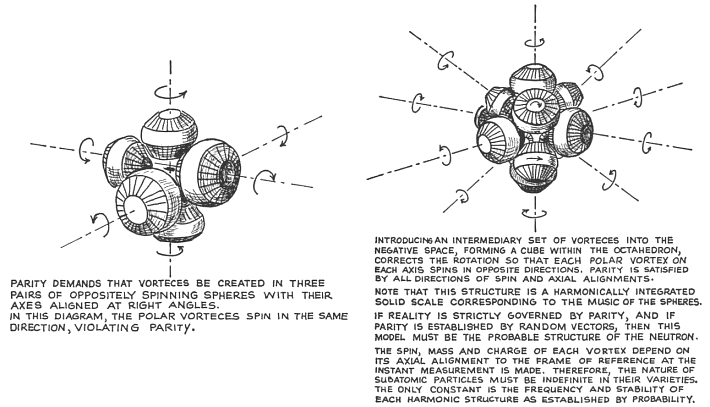
The cube-octa contains fourteen particles. If struck, it could collapse, with twelve arranging themselves around one in the center, in the form of a dodecahedron, while the fourteenth spins free into orbit. The transformation is remarkable similar to what appears to happen when a neutron is converted by impact into a proton and an electron.
If the proton has the geometry of a dodecahedron, it will be a charged particle, so every proton will seek another proton as a mate. This may be why hydrogen is a diatomic molecule. After the neutron collapses, parity is not reestablished absolutely until the helium atom is formed. This would explain why helium is monatomic, with all the properties of an overgrown neutron.
Now that we have our electrons, protons, and neutrons straightened out, let's put them all together!
Niels Bohr described the atom as a miniature Solar System, with the nucleus serving as a Sun, orbited by electron `planets'. The Bohr model is represented in all popular scientific literature despite the fact that any child can see it must be impossible. You see, if you have electrons orbiting in all directions around a nucleus, they are bound to collide; and on the atomic time scale, eventually is something sooner than a microsecond.
The atomic traffic problem was solved by giving each electron a different radius to orbit, but this solution won't work, either. An electron's wavelength is defined by its orbit. If every electron has its own orbital radius, each electron will manifest a different wavelength. This does not happen.
Erwin Schrödinger resolved the problem by proposing that electrons were standing waves, but his equations required three dimensions for each electron. Although the standing-wave equations were accepted, the necessity for multiplied space was not. As a consequence, mathematical physicists are still searching for a model that will make the atom possible! They have given up seeking a model that can be represented as a mechanical structure, and physics builds increasingly complicated and abstract equations.

The model of solid harmonics indicates that the node of the electronic standing wave revolves around the equator of the hydrogen nucleus. The node requires only half the quantum orbital space it has, so another electron can share the same shell to form a helium atom. To maintain parity, each moves to a polar hemisphere separated by the equator, and revolves in opposite directions.
Space is insufficient for a third electron, so the lithium atom must start another shell. The second shell has enough area for eight electrons, so the surface of each hemisphere is divided harmonically into successive halves, thirds, and quarters. Apparently the equatorial division establishes a hemispherical sector that is never crossed. The eight facets form the sides of an octahedron (the ubiquitous octahedron again) and each facet has just enough room to hold an electron; each facet is a quantum unit of space relative to the frequency of the electron. When the octahedron is complete, the atom is electrically neutral, as all octahedrons with their gears running smoothly are supposed to he, Neon is almost as inert as helium, but parity must be observed; and a second octahedron is laid over the first with the spins of each electron aligned at a different angle. The fourth orbital shell has sufficient radius for its surface to hold many more electrons. If you move the eight electrons to the vertices of the octahedron harmonic structure, so that each hemisphere is covered by a square pyramid with the equatorial cleavage separating them, you will find enough room to add another electron to the center of each facet, defining a cube- octa. The total of electrons will he eighteen; this is the number of electrons proven to be established in the subsequent shells in the generation of the Periodical Table of Elements. The electrons of each shell align their axes to balance parity.
But apparently it is a long way from helium to the next perfect atomic geometry. If the equatorial cleft is retained throughout the generation of elements, the model of heavier atoms will assume the dumbbell configuration of the electromagnetic field surrounding a bar magnet. (Structural weakness at the waist may be the reason that atoms heavier than bismuth break spontaneously.)
To illustrate how the geometry works in practice, the atom of carbon has a pair of miter caps, one over each polar hemisphere. There is space for two more electrons in each hemisphere to complete the octahedron. When it takes the electrons attached to hydrogen atoms, the hydrogen nucleus is going to stick out as a lump. In order to maintain parity, the angles at which the hydrogen atoms will join the carbon atom to form methane conform to the points of a tetrahedron. This fact is taken for granted in stereochemistry today, but established authorities put down the first chemist who suggested that molecules had solid structures, quite different from the empirical formulas used to describe them.
The oxygen atom is capped by three-sided pyramids with room for one more electron in each hemisphere. Parity allows a 120-degree angle between the hydrogen nuclei, and so water forms ice crystals in a hexagonal geometry.
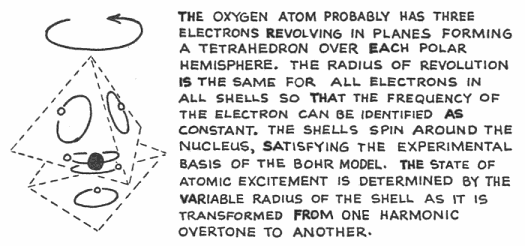
Outside of the innermost shells, electrons do not orbit the nucleus of their atoms at all; they orbit the space of their octahedronal facet at a constant radius. This geometry makes it possible to avert collisions and maintain a constant frequency of orbit, regardless of an electron's distance from its atomic center. When atoms are excited by absorbing radiation, a rotation in hyperspace causes the shells to move out to a greater radius from the nucleus to the positions calculated from experiment.
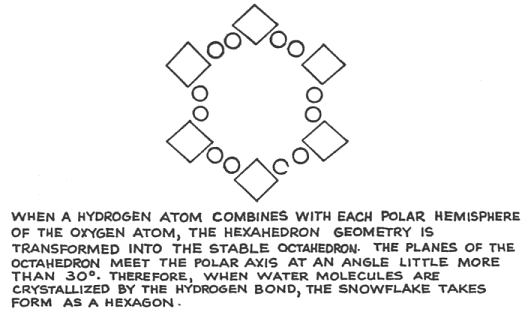
You have been taken along this line of superficial physics and chemistry to give you a basis for the possibility that all molecular structures are generated from the elementary geometry of the Platonic solids, with the elements combined in various combinations of harmonically integrated angles, like crystals. If this is so, then each chemical element and compound will resonate in sympathy to a specific geometric solid. Furthermore, each solid structure can be excited and modulated by musical sound. This is not a novel concept, but the very basis of alchemy.
Now, each solid can be transformed into another structure by a regular rotation through the hyperspace of the quantum field. Each chemical atom is also transformed by a rotation of its geometrical structure in hyperspace. Therefore, by employing tuned vibrations it is theoretically possible to transform lead into gold (or gold into oil, which is considerably more valuable these days).
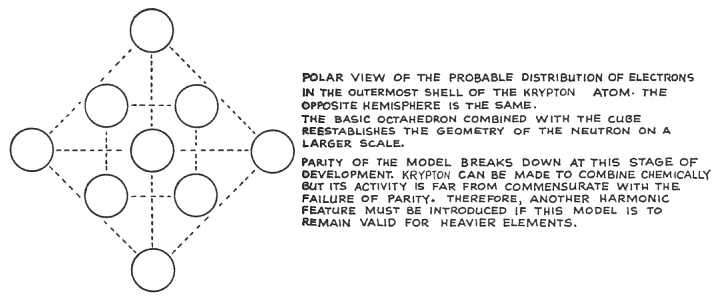
Fitting experimental data to the theory of solid harmonics is a task requiring professional competence. Even if the essential concept is correct, conflicting data is turning up day by day inspiring many false starts.
In the meantime, back at the bench, we have discovered the Philosophers' Stone. If a birdbrain can transmute the elements, so can engineering geniuses - as soon as we figure out how those stupid chickens did it.
By T. B. Paulicki
And See 'How to Build a Flying Saucer' @
Beyond Velikovsky
The Philosopher’s Stone @ http://nexusilluminati.blogspot.com.au/2011/06/philosophers-stone-how-to-transmute.html
Time Travel - How to Navigate Hyperspace @ http://nexusilluminati.blogspot.com.au/2011/08/time-travel-how-to-navigate-streams-of.html
Time Travel - How to Navigate Hyperspace @ http://nexusilluminati.blogspot.com.au/2011/08/time-travel-how-to-navigate-streams-of.html
Hope you like this
not for profit site -
It takes hours of work every day
to maintain, write, edit, research, illustrate and publish this website from a
tiny cabin in a remote forest
Like what we do? Please give enough
for a meal or drink if you can -
Donate any amount and receive at least one New Illuminati eBook!
Please click below -

Images - author's except opening image - http://farm9.staticflickr.com/8103/8639629642_17570b7fe0_h.jpg
For further enlightenment enter a word or phrase into the search box @ New Illuminati:
@ http://nexusilluminati.blogspot.com (or click on any tag at the bottom of the page for direct references)
And see
The Her(m)etic Hermit - http://hermetic.blog.com
New Illuminati – http://nexusilluminati.blogspot.com
New Illuminati on Facebook - http://www.facebook.com/pages/New-Illuminati/320674219559
This material is published under Creative Commons Copyright (unless an individual item is declared otherwise by copyright holder) – reproduction for non-profit use is permitted & encouraged, if you give attribution to the work & author - and please include a (preferably active) link to the original along with this notice. Feel free to make non-commercial hard (printed) or software copies or mirror sites - you never know how long something will stay glued to the web – but remember attribution! If you like what you see, please send a tiny donation or leave a comment – and thanks for reading this far…
From the New Illuminati – http://nexusilluminati.blogspot.com

Dear Plagiarists this is from Pawlicki's book "How to build a flying saucer" and I'd like to add that Pawlicki BELIEVES THE BIBLE according to his forward to Hyperspace on the Totse website. Therefore you scumbags solciting money for your vile satanic pagan at root Nimrod/Satan Serpent worship is disgusting. The illuminati, if you bothered to read anything with any real research like Robisons 1798 book on them and MANY other ones like Dope Inc etc, are disgusting excuses for human beings such as the Rothschild "family" and many more. See Springmeiers bloodlines book for a good start. I hope this disgusting site goes under.
ReplyDeletePlagiarism? We think not! Pawlicki/Paulicki (his name is spelt both ways in various sources) is clearly identified as the author AND this was actually wrtten as a magazine article before he used it in his inestimably valuable book - which is very hard to get these days!
ReplyDeleteFar from plagiarism, this is posted to spread the late great man's ideas further in a new millennium. You need to be more careful about imprecision in your accusations - copying something and providing attribution to the author is NOT plagirism. Satanic pagan Nimrods? You have to get your mind out of the Abrahamic gutter, oh bravely anonymous (and apparently antisemetic) one.
As for Robison's opinions, many, many groups with thoroughly diverse agendas have identified themselves as the 'illuminati', as you surely know. Do you have a link for the site you reference btw?
Ooo! Pretty! I just found your blog. It's great! Explore the Lomrod engineered stone exporters for great deals on marble and granite.
ReplyDeleteHi there mates, how is all, and what you would like to say concerning this
ReplyDeletearticle, in my view its truly awesome in favor of me.
Look at my web-site 대구오피
I've been searching for hours on this topic and finally found your post. 바카라사이트, I have read your post and I am very impressed. We prefer your opinion and will visit this site frequently to refer to your opinion. When would you like to visit my site?
ReplyDelete